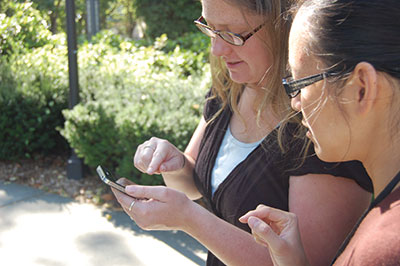University of Washington
|
Project: SpaceScout Mobile App
Project lead: Janice Fournier, research scientist
Tech vendors/partners:
|
Some innovations can be attributed to the domino effect. For instance, the temporary closure of a large student computer lab at the University of Washington in 2009 led UW Information Technology to research what students wanted in campus study spaces. "We knew they have more laptops now, but we didn't know whether they were bringing them to campus or whether we have the amenities to accommodate them," recalls research scientist Janice Fournier.
Subsequent surveys and focus groups found that students were not aware of many spaces and resources available to them and were often frustrated in trying to find places that met their specific needs: for example, a study room for six with a whiteboard and nearby coffee. That research later inspired Fournier and a team of software developers to create a mobile app called SpaceScout, which helps students find appropriate study spaces on campus.

University of Washington students can find study spaces—and nearby food and coffee—via mobile or web app. |
In January 2012, the Academic & Collaborative Applications team got $57,000 in funding from the Student Technology Fee Committee in addition to approximately $70,000 in in-kind donations of programmer and designer time from the IT department. By autumn 2012, a nine-person project team had delivered iOS and web-based apps to users. The team focused on an iOS version first because surveys revealed 75 percent of mobile devices on campus were iOS-based. Then the developers built a web app to make sure students without smartphones could still use the service.
SpaceScout allows any student with an iOS device or access to a web browser to search for campus study spaces by location on a map or by selecting type of space, capacity, hours available, whether or not the space is reservable, location, noise level, technology resources (e.g., projector), and proximity to food or coffee. Photos of each space help students choose exactly what they are looking for.
To get the project rolling, the team partnered with UW Libraries, Housing & Food Services, and computing directors to build a database of spaces and resources available to students. That was when the developers first appreciated the complexity of their task. "When we started collecting data in a spreadsheet, we realized that there was no consistency in how different groups labeled spaces," says Fournier. They had to stop and create definitions of nine different space types.
"Creating the spaces taxonomy and gathering the data about spaces took longer than we had anticipated," recalls Jason Civjan, user experience designer and project manager. "But now we have disseminated that taxonomy to the administrative owners of the spaces, and they can refer to those definitions as they describe new spaces."
The team developed SpaceScout in-house using open source tools such as Django, jQuery, and various plug-ins. The open source design means that other institutions can adapt SpaceScout to fit their own campuses and purposes. Indeed, the University of Illinois already has looked at ways it could use the web app and contributed some improvements to the code, Fournier says.
SpaceScout was the design team's first attempt at building a native iOS app, which the developers described as a steep learning curve. Unforeseen was a bug that didn't appear until they compiled the app for submission to the Apple App Store.
SpaceScout has been accessed more than 6,000 times since its release in the fall. Last December, 98 percent of surveyed users said they would recommend it. But the SpaceScout team is not resting on its laurels: It's focusing on a marketing plan to raise awareness of the app and increase the number of users. "We also are working on tools so administrators can edit their space information, see statistics about usage and what students are filtering for, and perhaps make adjustments accordingly," Civjan says. In other words, information from the app on users' habits will inform campus planners about the kinds of spaces students need most.
The developers are busy adding spaces from the UW Bothell and UW Tacoma campuses and integrating real-time data about availability in computer labs. Among proposed new features for 2014 include crowdsourcing, to allow students to rate and comment on spaces, and collaboration, to allow students to e-mail space details and invite others to a space. Another possibility is personalization, which would allow students to view spaces available to a specific group such as business majors.
The anecdotal feedback from students is encouraging, Fournier says. "Students say they are surprised at the number of spaces available," she adds. "One said that she orders a latte at a campus coffee shop and while waiting in line, she uses SpaceScout to find a place to study before her latte is ready. Another said she is staying on campus between classes more often because now she can find quiet study spaces."